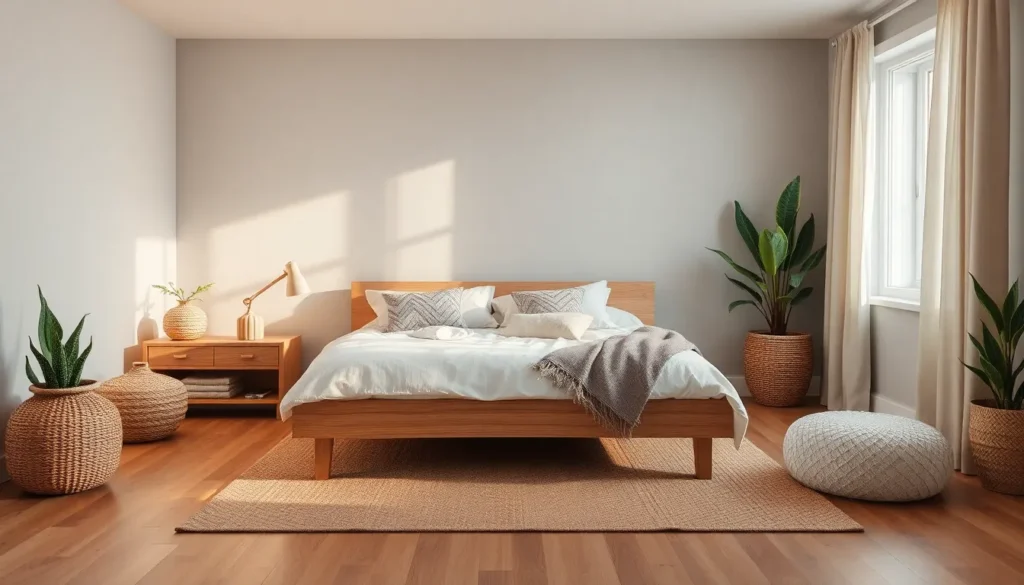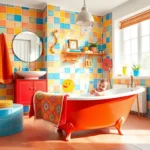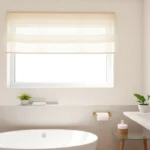When we’re designing our personal sanctuary, neutral bedroom ideas offer the perfect foundation for creating a space that feels both timeless and tranquil. These versatile color palettes work with any style preference and adapt beautifully as our tastes evolve over time.
We’ve discovered that neutral doesn’t mean boring – it means sophisticated. From warm beiges and soft grays to crisp whites and earthy taupes, neutral tones create a calming atmosphere that promotes better sleep and relaxation. They also provide the ideal backdrop for layering textures, patterns, and accent colors that reflect our personality.
Whether we’re working with a small space or a spacious master suite, neutral bedroom designs maximize natural light and create an illusion of larger, more open rooms. We’ll explore how these classic color schemes can transform any bedroom into a stylish retreat that stands the test of time.
Choose a Calming Color Palette With Warm and Cool Neutrals
Creating the perfect neutral bedroom starts with selecting colors that promote serenity and comfort. We’ll explore how warm and cool neutrals work together to establish a balanced atmosphere that encourages restful sleep.
Incorporate Soft Beiges and Creamy Whites
Soft beiges form the foundation of any warm neutral palette by adding gentle warmth without overwhelming the space. We recommend using beige on larger surfaces like walls or bedding to create an inviting backdrop that feels naturally cozy. Creamy whites complement beige beautifully by introducing brightness while maintaining the warm undertone that makes a room feel welcoming.
These warm neutrals work particularly well in bedrooms with limited natural light since they reflect available light effectively. We’ve found that pairing cream colored linens with beige accent walls creates depth while keeping the overall feel light and airy. Consider using these tones in varying intensities throughout your space to avoid a flat, monotonous appearance.
Add Depth With Greige and Mushroom Tones
Greige combines the warmth of beige with the sophistication of gray to create a contemporary neutral that feels both modern and timeless. We suggest using greige on focal walls or in larger furniture pieces like upholstered headboards to anchor the room’s design. Mushroom tones add earthiness to your neutral palette while providing a rich backdrop for lighter accent pieces.
These hybrid colors bridge the gap between warm and cool neutrals seamlessly. We recommend layering different shades of greige through textiles like throw pillows, curtains, and area rugs to create visual interest. Mushroom colored elements work especially well as grounding pieces such as wooden furniture or ceramic accessories.
Balance With Cool Grays and Soft Taupe
Cool grays introduce a calming element that balances warmer tones in your neutral bedroom palette. We use soft gray in areas where we want to create visual breathing room, such as ceiling colors or accent furniture pieces. Soft taupe provides a sophisticated middle ground between warm and cool neutrals that helps tie the entire color scheme together.
Strategic placement of these cooler tones prevents your bedroom from feeling too warm or overwhelming. We recommend incorporating cool gray through metallic fixtures, picture frames, or decorative objects to add subtle contrast. Taupe works beautifully in larger textiles like comforters or window treatments where you need substantial color presence without dramatic temperature shifts in your overall palette.
Layer Different Textures to Create Visual Interest
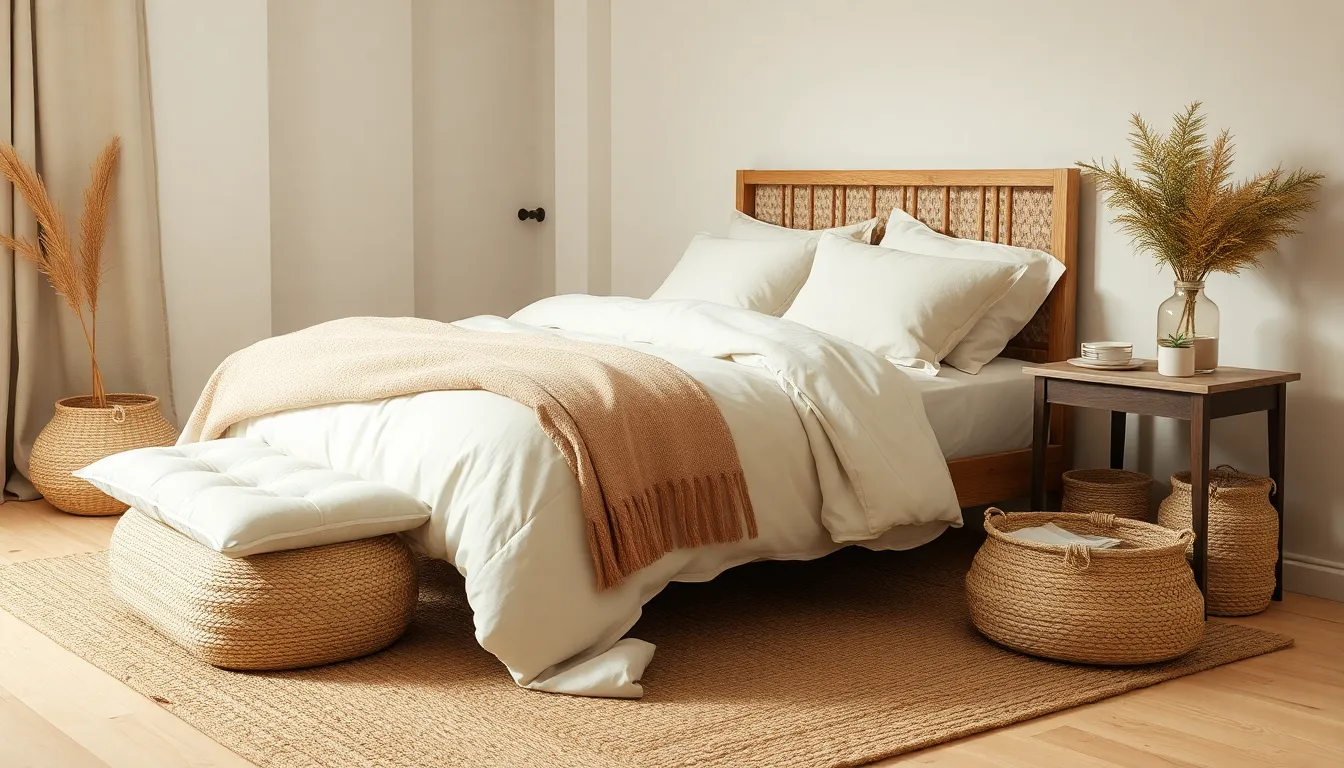
Building on our neutral color foundation, we’ll explore how strategic texture layering transforms a simple bedroom into a ever-changing, visually captivating space.
Mix Linen and Cotton Bedding
Linen bedding brings rustic charm while cotton provides essential softness for optimal comfort. We recommend starting with a cotton base sheet set in warm white or soft beige, then adding linen pillowcases and a throw blanket in complementary neutral tones. This combination creates natural visual depth without disrupting our calming color palette.
Cotton’s smooth finish contrasts beautifully with linen’s relaxed, slightly wrinkled texture. We’ve found that mixing these materials in similar neutral shades maintains cohesion while adding the tactile variety that makes neutral bedrooms feel inviting rather than flat. Consider pairing crisp white cotton sheets with oatmeal linen pillowcases or sage green linen duvet covers with cream cotton shams.
Incorporate Natural Fiber Rugs
Natural fiber rugs in jute or sisal materials bring warmth and organic texture that perfectly complements neutral bedroom schemes. These rugs create a grounding element that connects our neutral walls and bedding to the floor, establishing visual continuity throughout the space.
Jute rugs offer a slightly softer feel underfoot while maintaining durability, making them ideal for bedroom placement. We suggest choosing oversized rugs that extend beyond the bed frame to create a cohesive look. Sisal rugs provide more structured texture with their tighter weave, perfect for adding subtle pattern variation without introducing competing colors.
Add Woven Baskets and Rattan Accents
Woven baskets and rattan pieces introduce natural elements that serve dual purposes as storage answers and decorative focal points. We recommend placing large woven baskets near the bed for blanket storage or using smaller rattan containers on nightstands for organizing essentials.
Rattan headboards create stunning texture statements while maintaining our neutral aesthetic. These natural materials add organic curves and patterns that soften the straight lines typically found in bedroom furniture. We’ve seen great results with rattan pendant lights, woven wall hangings, and bamboo picture frames that reinforce the natural texture theme without overwhelming the space.
Select Natural Wood Furniture for Warmth and Character
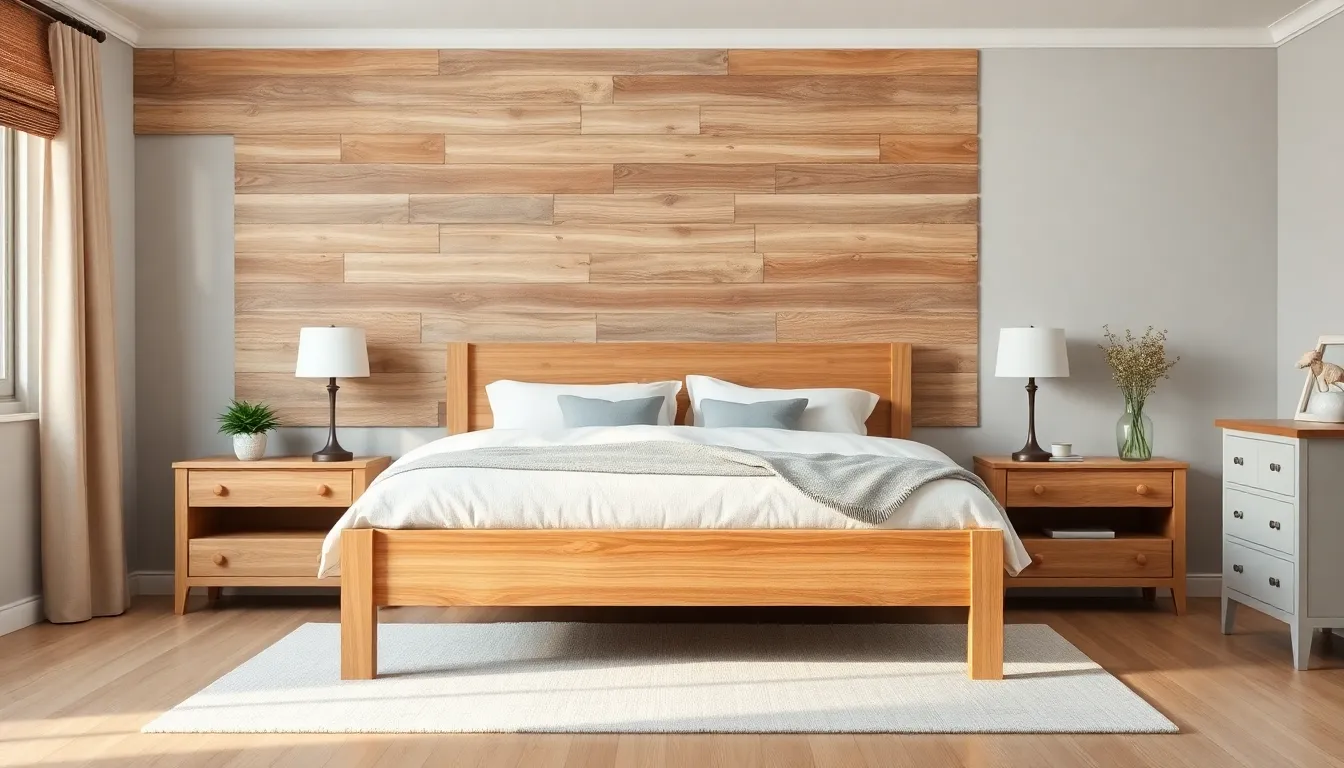
Natural wood furniture forms the backbone of neutral bedroom design by introducing organic warmth that complements our carefully chosen color palette. Wood pieces create visual anchors while maintaining the serene atmosphere we’ve established through texture layering.
Choose Light Oak or Maple Pieces
Light oak brings exceptional warmth and character to neutral bedrooms without overpowering the space. We recommend incorporating oak bed frames as statement pieces that ground the room while allowing other design elements to shine. Maple nightstands offer beautiful grain patterns that add visual interest alongside their practical storage benefits.
These light wood species work particularly well with the beige and cream foundations we’ve discussed. Oak dressers provide substantial storage while contributing to the room’s natural texture story. Maple pieces complement linen bedding and cotton elements by echoing their organic qualities in wood form.
Incorporate Reclaimed Wood Elements
Reclaimed wood elements bring unique history and texture that enhances our neutral bedroom’s depth. We suggest using reclaimed wood for accent walls behind the bed to create a stunning focal point. This approach adds character without disrupting the calm atmosphere we’ve cultivated through our color choices.
Reclaimed wood headboards offer another excellent way to introduce this weathered texture. Floating shelves made from reclaimed materials provide both function and visual appeal while reinforcing our natural theme. These pieces carry stories and imperfections that add authenticity to the space.
Balance With Painted Wood in Soft Neutrals
Painted wood in soft neutrals creates harmonious balance when combined with natural wood pieces. We recommend painting select furniture items in beige, cream, or soft gray to complement our established color palette. This technique prevents the space from feeling too wood heavy while maintaining cohesion.
Consider painting nightstands in warm beige while keeping the bed frame in natural oak. Cream painted dressers work beautifully alongside maple accent pieces. This balanced approach allows us to enjoy wood’s warmth while ensuring our neutral foundation remains the star of the design.
Incorporate Plants and Natural Elements for Organic Appeal
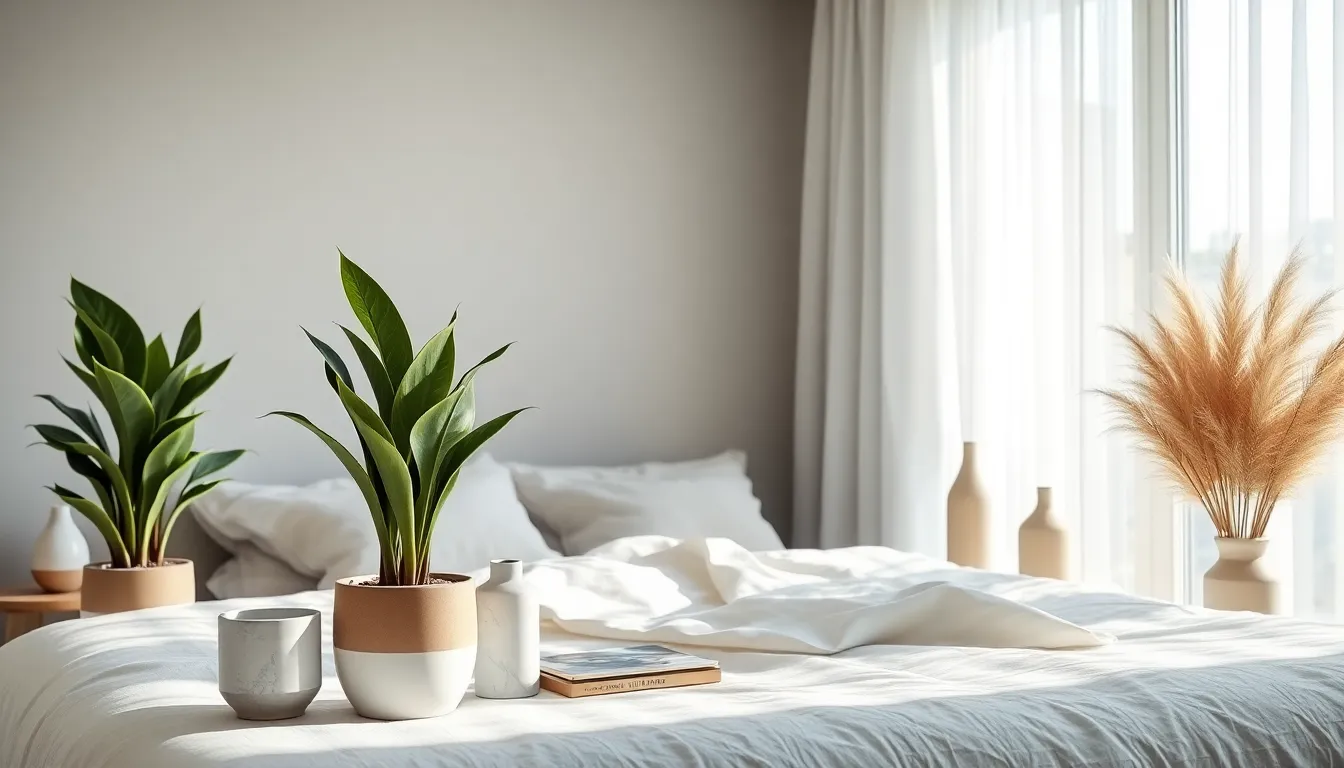
Building on your neutral foundation and natural textures, we’ll enhance the space with living and organic elements that breathe life into your serene bedroom retreat.
Add Low-Maintenance Greenery Like Snake Plants
Snake plants serve as perfect companions for neutral bedrooms, requiring minimal care while providing maximum visual impact. These resilient plants thrive in various lighting conditions and add vertical interest to corners or nightstands without overwhelming your carefully curated color scheme. We recommend placing snake plants in neutral ceramic or natural fiber planters that complement your existing decor palette.
Pothos and ZZ plants offer additional low-maintenance options that cascade beautifully from floating shelves or tall plant stands. Their trailing vines create gentle movement and soften harsh angles while maintaining the clean lines essential to neutral design. Consider grouping plants at varying heights to create natural vignettes that draw the eye upward and make your space feel more expansive.
Display Natural Stone and Crystal Accents
Marble elements introduce sophisticated texture through decorative trays, bookends, or small sculptural pieces placed on dressers and nightstands. The natural veining in marble adds subtle pattern without disrupting your neutral color story, while limestone accents provide a softer, more matte finish that complements linen and cotton textures beautifully.
Crystal displays create focal points that catch and reflect natural light throughout your bedroom space. Rose quartz specimens align perfectly with warm neutral palettes, while clear quartz amplifies the brightness of your room. We suggest arranging crystals on wooden floating shelves or within natural woven baskets to maintain the organic aesthetic while adding these sparkling elements.
Include Dried Branches and Pampas Grass
Dried branches transform empty corners into artistic statements when arranged in tall ceramic or glass vases that echo your neutral color scheme. Birch branches with their natural white bark complement cool grays and whites, while darker branches like willow or eucalyptus pair beautifully with warmer beiges and taupes. These elements add height and sculptural interest without requiring water or ongoing maintenance.
Pampas grass brings soft, feathery texture that contrasts beautifully with the clean lines of modern neutral furniture. We recommend displaying pampas grass in grouped arrangements of varying heights, using neutral vases in cream, beige, or soft gray tones. This creates dramatic yet peaceful focal points that reinforce the connection between your indoor sanctuary and the natural industry outside.
Focus on Ambient Lighting to Enhance the Peaceful Atmosphere
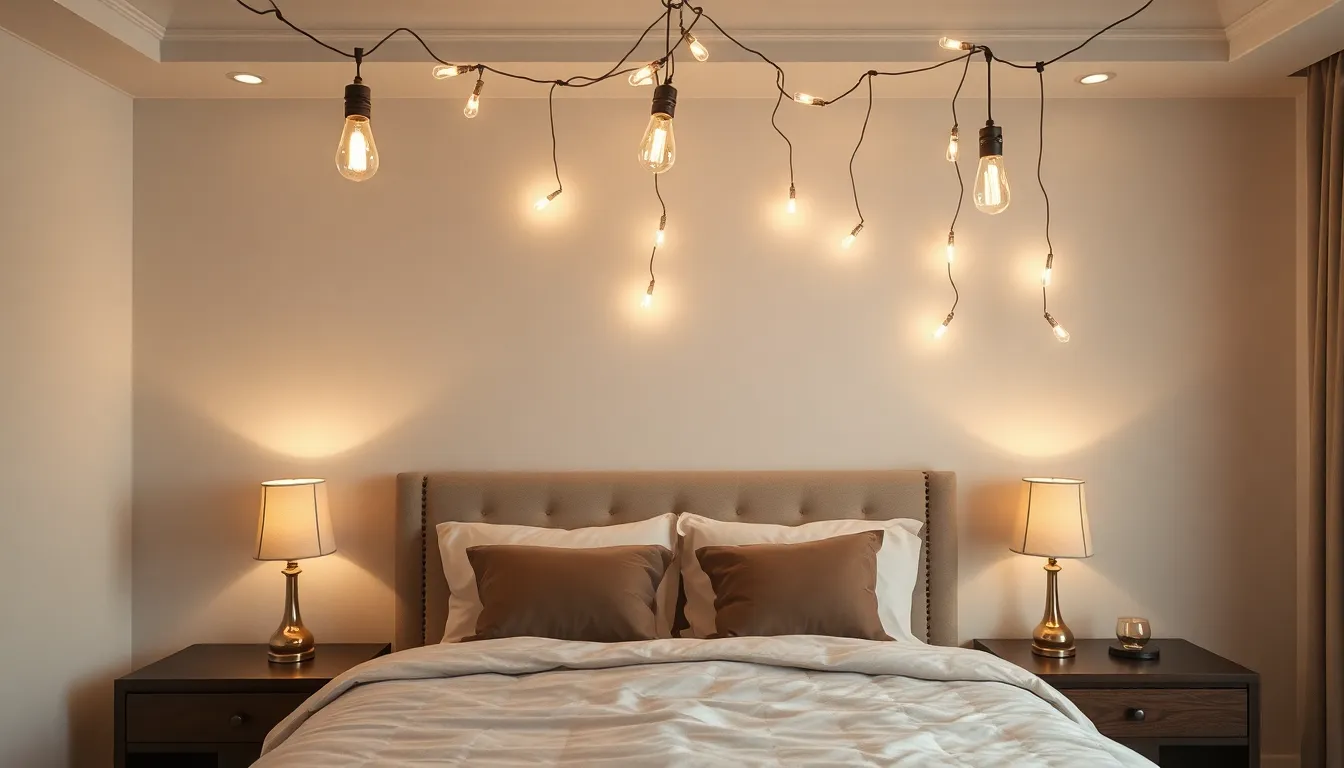
Ambient lighting transforms neutral bedrooms into serene sanctuaries that promote relaxation and restful sleep. Strategic placement of warm, layered lighting elements creates the perfect atmosphere to complement our carefully chosen neutral color palette and natural textures.
Install Warm LED Bulbs in Ceiling Fixtures
Warm LED bulbs with 2700K to 3000K color temperature create the foundation for our ambient lighting scheme. These gentle overhead lights cast a soft, inviting glow that beautifully complements neutral wall colors and natural materials like wood, stone, and woven textiles. Installing warm toned bulbs prevents the clinical feel that cooler lighting can introduce, ensuring our bedroom maintains its cozy and restful atmosphere. The amber undertones of these bulbs enhance the warmth of beige and taupe colors while softening cool grays, creating perfect balance throughout the space.
Add Table Lamps With Fabric Shades
Table lamps with fabric or linen shades diffuse light gently across our neutral bedroom, reducing harsh shadows that can disrupt the serene environment. Placing these lamps on nightstands or dressers adds essential layers of light that create depth and visual interest in minimalist spaces. Fabric shades in cotton or linen materials maintain consistency with our natural texture theme while providing the soft illumination needed for bedtime routines. These layered lighting elements work together with overhead fixtures to establish the multi dimensional ambiance that makes neutral bedrooms feel sophisticated yet welcoming.
Include String Lights for Cozy Evening Ambiance
String lights introduce whimsical warmth perfect for creating intimate evening atmospheres in our neutral retreat. Draping these lights above the bed, around a headboard, or along accent walls adds subtle focal points without overwhelming the minimalist aesthetic. Their soft, indirect glow complements the established lighting layers while providing that extra touch of coziness during quiet evening hours. String lights prove especially effective in smaller bedrooms, where they deliver maximum ambiance impact without competing with our carefully balanced color palette and natural elements.
Minimize Clutter With Smart Storage Solutions
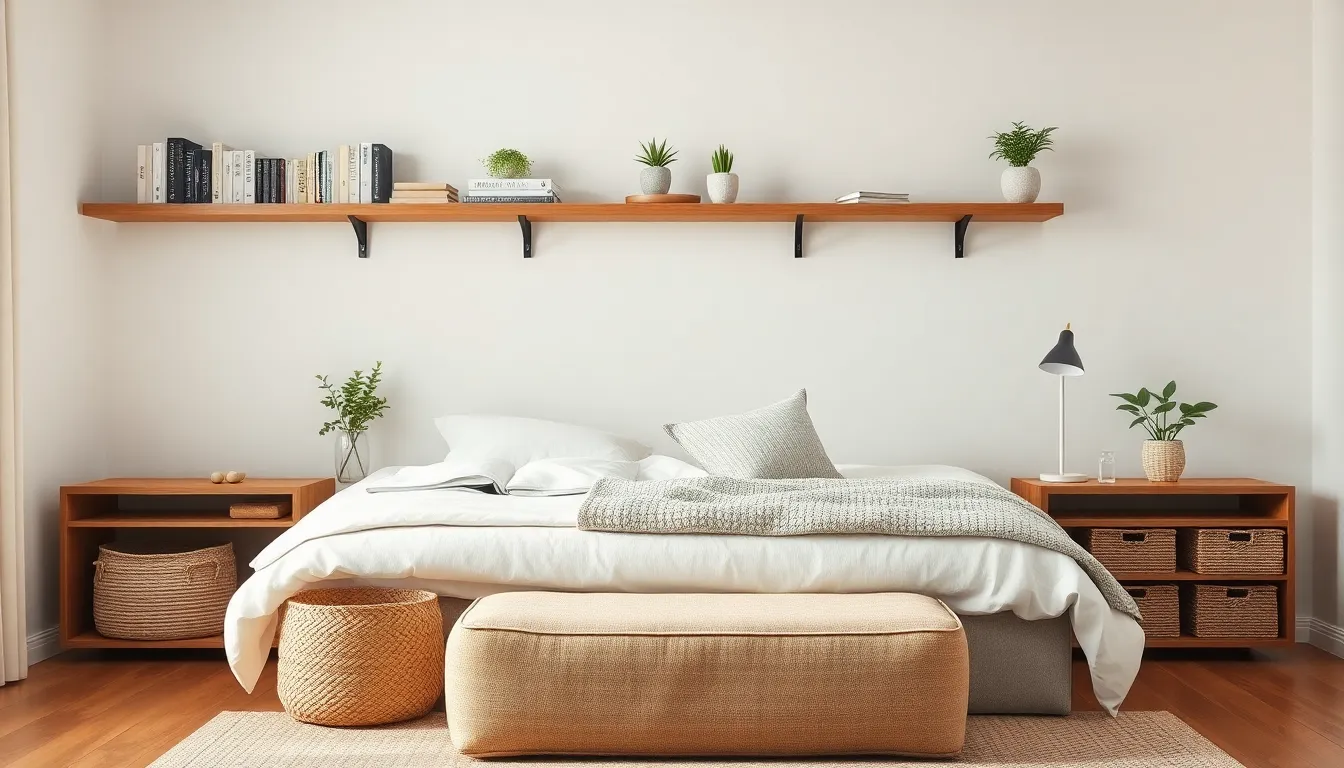
Smart storage answers maintain the serene atmosphere we’ve established with our neutral color palette and natural textures. We can achieve a clutter-free bedroom while preserving the calming aesthetic through strategic organization choices.
Use Neutral Storage Baskets Under the Bed
Neutral storage baskets under the bed provide hidden organization without disrupting our carefully curated bedroom design. We recommend choosing woven baskets in natural materials like rattan, jute, or bamboo that complement the organic textures we’ve already incorporated. These baskets work perfectly for storing seasonal bedding, extra pillows, or out-of-season clothing while maintaining easy access.
Canvas storage bins in soft beiges or warm grays offer another excellent option for under-bed organization. We can select baskets with fitted lids to keep dust away from stored items while creating clean lines that enhance our minimalist aesthetic. Natural fiber baskets also reinforce the textural elements we’ve established with our rugs and furniture choices.
Install Floating Shelves in Matching Wood Tones
Floating shelves in matching wood tones create visual continuity with our natural wood furniture pieces. We should select shelves in light oak or maple finishes that coordinate with our existing bed frames and nightstands. These sleek storage answers keep essentials like books, small plants, and decorative objects within reach without adding visual bulk.
Strategic placement of floating shelves maximizes our vertical space while maintaining the room’s balanced proportions. We can install them at varying heights to create visual interest and accommodate different sized items. The clean lines of floating shelves complement our modern neutral aesthetic while providing practical storage for daily essentials.
Choose Furniture With Hidden Storage Compartments
Furniture with hidden storage compartments serves dual purposes in our neutral bedroom design. We can select bed frames with built-in drawers that slide seamlessly beneath the mattress, providing ample space for linens and clothing. These integrated storage answers eliminate the need for additional furniture pieces that might clutter our peaceful space.
Nightstands with concealed compartments keep personal items organized while maintaining clean surfaces for our ambient lighting fixtures. We should choose pieces that feature soft-close drawers or hidden shelving that aligns with our neutral color scheme. Ottoman storage benches at the foot of the bed offer seating while housing extra blankets or pillows, maximizing functionality without compromising our serene aesthetic.
Add Subtle Patterns and Art for Visual Depth
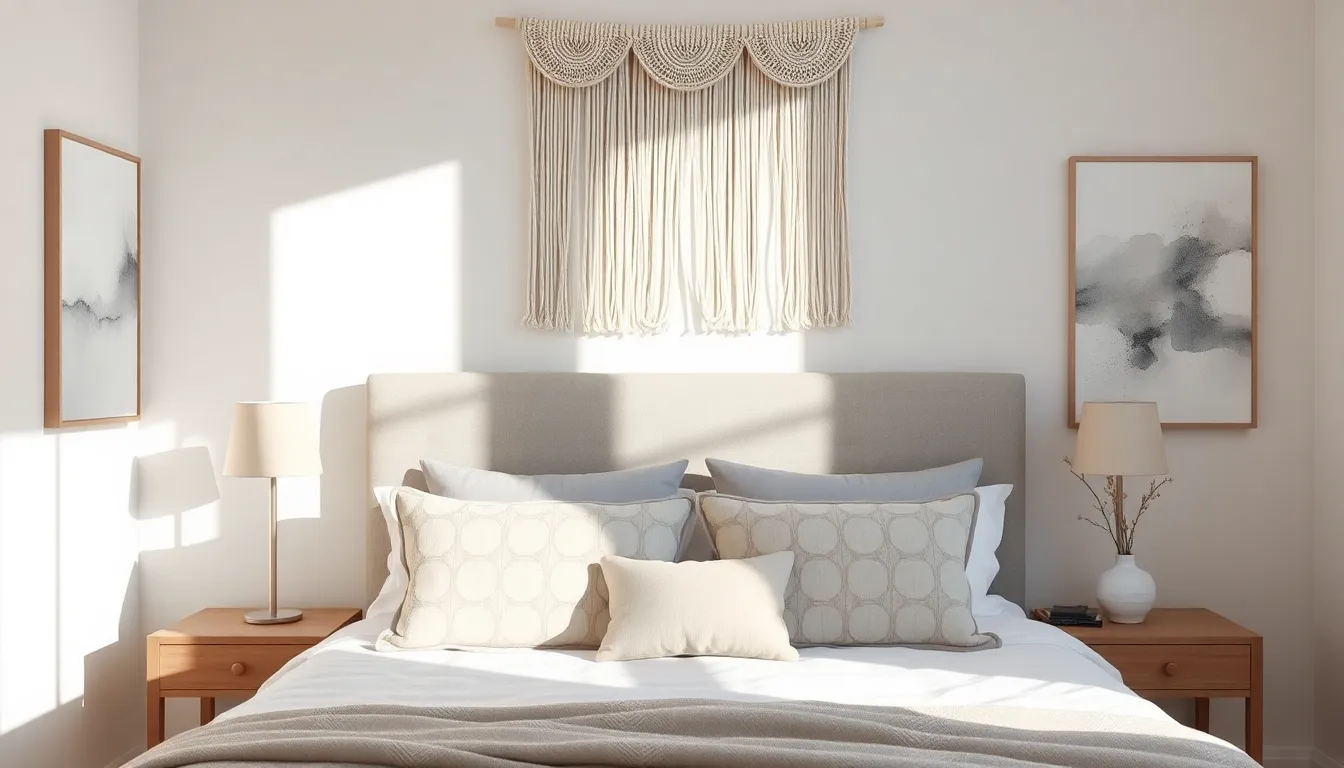
Building on your organized foundation, we’ll explore how strategic visual elements can elevate neutral bedrooms without disrupting their serene atmosphere. Subtle patterns and carefully chosen artwork create visual interest while maintaining the peaceful environment you’ve established.
Incorporate Geometric Patterns in Throw Pillows
Geometric patterns introduce visual interest through structured designs that complement rather than compete with your neutral palette. We recommend selecting throw pillows featuring subtle hexagons, diamonds, or linear patterns in tones that echo your existing color scheme. Soft gray triangles on cream backgrounds work beautifully alongside beige bedding, while muted gold circles add warmth without overwhelming the space.
Mixing different geometric shapes creates ever-changing visual texture when you keep the colors within your established neutral range. Square pillows with diamond patterns pair excellently with rectangular cushions featuring thin stripes or dots. We suggest using varying sizes to create depth, placing larger 20-inch geometric pillows behind smaller 16-inch solid ones for layered sophistication.
Fabric choices amplify the impact of geometric patterns in neutral bedroom designs. Linen geometric pillows provide organic texture that softens angular designs, while cotton blends offer crisp definition that enhances pattern clarity. We’ve found that combining matte and slightly lustrous fabrics within the same geometric theme adds subtle dimension without breaking from your neutral foundation.
Choose Abstract Art in Neutral Tones
Abstract art pieces in neutral tones create sophisticated focal points that enhance your bedroom’s calming environment. We recommend selecting artwork featuring soft brushstrokes in whites, creams, and gentle grays that mirror your established color palette. Watercolor abstracts work particularly well, offering fluid movement that contrasts beautifully with the structured lines of your furniture and textiles.
Oversized abstract pieces make powerful statements while maintaining serenity when you choose muted color schemes. Canvas prints measuring 36 by 48 inches or larger command attention above headboards without overwhelming smaller bedrooms. We suggest abstract landscapes or organic forms that suggest natural elements like clouds, stones, or flowing water to reinforce your connection with nature.
Gallery walls featuring multiple abstract pieces allow for creative expression within neutral parameters. Arranging three to five smaller abstracts in varying sizes creates visual rhythm while maintaining cohesion through consistent color themes. We recommend using white or natural wood frames to unify different pieces, ensuring your art collection enhances rather than disrupts your peaceful bedroom aesthetic.
Add Textured Wall Hangings Like Macrame
Macrame wall hangings introduce bohemian texture that softens hard surfaces while maintaining neutral bedroom elegance. We suggest positioning large macrame pieces above headboards or on accent walls where their organic patterns create visual interest without competing with other design elements. Natural cotton and jute fibers work best, offering cream and beige tones that blend seamlessly with your established palette.
Woven wall hangings provide alternative texture options that complement macrame’s organic appeal. Tapestries featuring neutral geometric patterns or abstract designs add visual depth while maintaining the serene atmosphere you’ve cultivated. We recommend selecting pieces with subtle variations in texture rather than bold colors, allowing the weaving techniques themselves to create visual interest.
Layering different textured wall hangings creates sophisticated dimensional displays that enhance your neutral bedroom’s visual appeal. Combining smaller macrame pieces with woven baskets or textile art creates curated gallery walls that feel intentional rather than cluttered. We suggest maintaining consistent spacing and using odd numbers of pieces for the most pleasing visual arrangements that support your room’s peaceful ambiance.
Conclusion
Creating a neutral bedroom that feels both serene and sophisticated doesn’t have to be overwhelming. We’ve shown you how thoughtful color choices paired with natural textures and smart design elements can transform your space into a peaceful retreat.
The beauty of neutral bedroom design lies in its flexibility and longevity. These timeless palettes won’t go out of style and they’ll continue to provide the calming atmosphere you need for quality rest.
Start with one or two elements that resonate with you most – whether it’s incorporating natural wood furniture or adding layered lighting. From there you can gradually build your neutral sanctuary at your own pace.
Your bedroom should be your personal haven and these neutral design principles will help you create exactly that.
Frequently Asked Questions
What are the best neutral colors for a bedroom?
The best neutral colors for bedrooms include warm beiges, soft grays, creamy whites, and earthy taupes. These colors create a sophisticated, calming atmosphere that promotes relaxation and better sleep. Greige and mushroom tones add depth, while cool grays help balance warmer neutrals for a harmonious palette.
How do neutral colors make a bedroom look bigger?
Neutral colors enhance natural light and create visual continuity, which makes spaces appear larger. Light neutrals like creamy whites and soft beiges reflect more light, opening up the room. The lack of bold, contrasting colors creates a seamless flow that doesn’t break up the space visually.
What textures work best with neutral bedroom colors?
Mix linen and cotton bedding for sophistication, add natural fiber rugs like jute or sisal for warmth, and incorporate woven baskets and rattan accents. These organic textures create visual interest without overwhelming the serene neutral palette, adding depth and tactile appeal to the space.
How should I incorporate wood furniture in a neutral bedroom?
Choose light oak and maple pieces for bed frames and nightstands to complement neutral palettes. Consider reclaimed wood for accent walls or headboards to add character. Paint select furniture pieces in soft neutrals to maintain cohesion while allowing the natural wood’s warmth to shine through.
What plants work well in neutral bedrooms?
Low-maintenance plants like snake plants, pothos, and ZZ plants are ideal for neutral bedrooms. These plants provide visual interest and soften the space without overwhelming the color palette. They add life and organic appeal while maintaining the serene, peaceful atmosphere.
What lighting is best for neutral bedrooms?
Use warm LED bulbs with 2700K to 3000K color temperature in ceiling fixtures for a soft glow. Add table lamps with fabric shades to diffuse light gently and reduce harsh shadows. String lights can create cozy evening ambiance, creating a layered lighting approach.
How can I add storage without disrupting the neutral design?
Use neutral storage baskets made from rattan or jute under the bed for seasonal items. Install floating shelves in matching wood tones for visual continuity. Choose furniture with hidden compartments like bed frames with built-in drawers to maximize functionality while maintaining aesthetics.
Can I add patterns to a neutral bedroom?
Yes, incorporate geometric patterns in throw pillows using varying sizes and shapes for sophistication. Choose abstract art in neutral tones for focal points, and consider textured wall hangings like macrame or woven tapestries. Keep patterns subtle to maintain the serene atmosphere.

